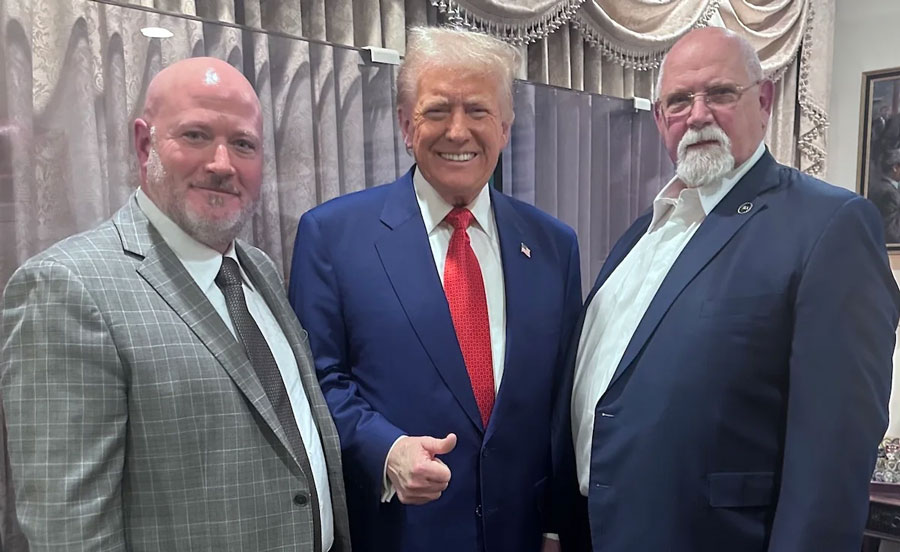


Is this the end of the road for East Coast port employers?
That's how it initially felt when President-elect Donald Trump publicly backed the International Longshoremen's Association to prevent it from bringing container automation technology to East Coast and Gulf Coast ports.
Mr. Trump, who has always relied on social media to govern, doubled down a few days later by retweeting a Facebook post from Dennis Daggett, the executive vice president of the International Bar Association, describing the meeting at Mr. Trump's Mar-a-Lago resort, Trump's father, Harold Daggett, president of the International Bar Association, also attended the meeting.
How long can the American Maritime Alliance, which represents Marine terminal operators and ocean shipping companies, resist this pressure?
From this perspective, all it takes is Trump's tariff threat to see Mexico and Canada quickly comply.
While new President Claudia Steinbaum initially threatened to impose tariffs on U.S. goods, that now seems unlikely as Mexico can ill afford a trade war with its largest trading partner given the weak peso.
In Canada, Ontario made noise about tariffs and the suspension of electricity sales to the U.S., but those seem to have fallen by the wayside, as we say in hockey, when Justin Trudeau's federal government announced $900 million for border security and a massive bust of fentanyl smugglers who were shipping thousands of doses of the potentially deadly drug into the U.S., Bingo, more preconditions set by Trump.
(Trudeau and his party have their own problems, trailing by just over 20 points in the polls amid lagging post-pandemic economic growth and persistent Labour unrest in industries ranging from ports and railways to Canada Post.)
Until this month, when the International Labor Organization explicitly revealed that semi-automated container cranes were blocking a new coastal contract involving tens of thousands of union workers from Maine to Texas, disrupting contract negotiations. Until now, the Gulf Coast Union has been happy to issue gently worded press releases that only mention automation technology. But that is no longer the case.
By any measure, ocean carriers have had a stellar year. Despite stagnant global markets, the U.S. economy, supported by strong consumer demand, is importing record amounts of goods through the U.S. container gateway, especially from China. Houthi attacks on ships in Yemen have diverted shipping routes around the Red Sea and the Horn of Africa, extending voyage to Europe, the Mediterranean and the United States, depleting capacity, driving up freight rates and boosting carriers' profits by billions of dollars.
While some cargoes were diverted to other ports during the three-day International Labour Association strike in October, importers (and exporters) do not appear to have a reasonable alternative to shipping by sea. Air transport is too costly to accommodate large and diverse transocean shipments, including agricultural products or vehicles, which also fall under the jurisdiction of the International Labour Association.
To be sure, executives have been reluctant to step up and be the public face of foreign shipping companies during negotiations, hurting their efforts to communicate effectively. The International Chamber of Shipping has repeatedly shouted about how automation will eliminate union jobs. Employers say port automation is necessary to make East Coast hubs more efficient, creating more union jobs to manage larger container volumes.
But carriers still have cards to play. While the Houthis signaled a major shift regarding the Red Sea this week amid the rapidly changing situation in the region, it could be months before carriers and their underwriters feel comfortable returning to the area, and only after the rebels withdraw. They also want to maintain these higher rates through the contract season and into 2025, when new ships and new alliances are expected to further change supply chain dynamics.
Therefore, it can be considered that another port strike is highly likely, but as before, it will be of short duration. As former President Joe Biden did, Trump won't stop the shutdown. It was Acting Labor Minister Julie Su who brokered the end of the strike, a 62 percent pay raise for the union and an extension of the existing contract until Jan. 15.
Smart investors hedge their bets. Trump could allow the ILA to strike for a week or less - when the boats really start lining up - and then swoop in to help hammer out a deal under which the union accepts a watered-down proposal to test automation in exchange for a promise to create more jobs. Trump won, the container moves went ahead, and longtime ILA President Harold Daggett received a leaving gift as he handed over the union's REINS to his son.
But now, with negotiations stalled and an extension deadline looming, there appears to be no such candidate as Julie Su, as Trump's cabinet picks are still months away. While the Taft-Hartley Act gives the president the power to order an end to a strike if it endangers American security, as President George W. Bush did with the West Coast longshoremen lockout in 2002, it is hard to imagine Trump forcing the International Labor Association to return to work.





